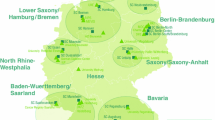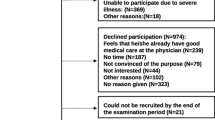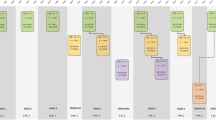Abstract
There is a public health demand to prevent health conditions which lead to increased morbidity and mortality among the rapidly-increasing elderly population. Data for the incidence of such conditions exist in cohort studies worldwide, which, however, differ in various aspects. The Consortium on Health and Ageing: Network of Cohorts in Europe and the United States (CHANCES) project aims at harmonizing data from existing major longitudinal studies for the elderly whilst focussing on cardiovascular diseases, diabetes mellitus, cancer, fractures and cognitive impairment in order to estimate their prevalence, incidence and cause-specific mortality, and identify lifestyle, socioeconomic, and genetic determinants and biomarkers for the incidence of and mortality from these conditions. A survey instrument assessing ageing-related conditions of the elderly will be also developed. Fourteen cohort studies participate in CHANCES with 683,228 elderly (and 150,210 deaths), from 23 European and three non-European countries. So far, 287 variables on health conditions and a variety of exposures, including biomarkers and genetic data have been harmonized. Different research hypotheses are investigated with meta-analyses. The results which will be produced can help international organizations, governments and policy-makers to better understand the broader implications and consequences of ageing and thus make informed decisions.
Similar content being viewed by others
References
World Health Organization. 2008–2013 Action plan for the global strategy for the prevention and control of noncommunicable diseases. Geneva: WHO; 2008.
United Nations. Political declaration of the high-level meeting of the general assembly on the prevention and control of non communicable diseases United Nations. 2011. http://www.un.org/ga/search/view_doc.asp?symbol=A/66/L.1. Assessed 30 Dec 2013.
World Health Organization. Active ageing. A policy framework. 2002. http://whqlibdoc.who.int/hq/2002/who_nmh_nph_02.8.pdf. Accessed 2 July 2012.
Newman AB, Arnold AM, Naydeck BL, Fried LP, Burke GL, Enright P, et al. “Successful aging”: effect of subclinical cardiovascular disease. Arch Intern Med. 2003;163(19):2315–22.
World Health Organization. Preventing chronic diseases: a vital investment. 2005. http://www.who.int/chp/chronic_disease_report/en/ Accessed 2 July 2012.
Bianchi L, Zuliani G, Volpato S. Physical disability in the elderly with diabetes: epidemiology and mechanisms. Curr Diab Rep. 2013;13:824–30.
Jemal A, Ward E, Hao Y, Thun M. Trends in the leading causes of death in the United States, 1970–2002. JAMA. 2005;294:1255–9.
Aronow WS. Heart disease and ageing. Med Clin N Am. 2006;90:849–62.
Murray CJ, Lopez AD. Measuring the global burden of disease. N Engl J Med. 2013;369:448–57.
World Health Organization. Diabetes fact Sheet No 312. 2012. http://www.who.int/mediacentre/factsheets/fs312/en/index.html. Accessed 30 Dec 2013.
Ferlay J, Shin H, Bray F, Forman D, Mathers C, Parkin DM. Estimates of worldwide burden of cancer in 2008: GLOBOCAN. IJC. 2010;127:2893–917.
Pawelec G, Barnett Y, Forsey R, Frasca D, Globerson A, McLeod J, et al. T cells and aging. Front Biosci. 2002;2002(1):1056–83.
Gielen E, Verschueren S, O’Neill TW, Pye SR, O’Connell MD, Lee DM, et al. Musculoskeletal frailty: a geriatric syndrome at the core of fracture occurrence in older age. Calcif Tissue Int. 2012;91:161–77.
Johnell O, Kanis JA. An estimate of the worldwide prevalence and disability associated with osteoporotic fractures. Osteoporos Int. 2006;17:1726–33.
Cummings SR, Melton LJ. Epidemiology and outcomes of osteoporotic fractures. Lancet. 2002;359:1761–7.
Kannus P, Parkkari J, Sievänen H, Heinonen A, Vuori I, Järvinen M. Epidemiology of hip fractures. Bone. 1996;18(1 suppl):57S–63S.
Centre JR, Nguyeen TV, Schneider D, Sambrook PN, Eisman JR. Mortality after all types of osteoporotic fracture in men and women: an observational study. Lancet. 1999;353:878–82.
Brayne C. The elephant in the room: healthy brains in later life, epidemiology and public health. Nat Rev Neurosci. 2007;8:233–9.
Deary IJ, Corley J, Gow AJ, Harris SE, Houlihan LM, Marioni RE, et al. Age-associated cognitive decline. Br Med Bull. 2009;92:135–52.
World Health Organization. The global burden of disease: 2004 update. 2004. http://www.who.int/healthinfo/global_burden_disease/GBD_report_2004update_full.pdf. Αccessed 2 July 2012.
Le Marchand L, Kolonel LN, Hankin JH, Yoshizawa CN. Relationship of alcohol consumption to diet: a population-based study in Hawaii. Am J Clin Nutr. 1989;49:567–72.
Juster FT, Suzman R. An overview of the Health and Retirement Study. J Hum Resour. 1995;30(suppl):S7–56.
Healy GN, Wijndaele K, Dunstan DW, Shaw JE, Salmon J, Zimmet PZ, et al. Objectively measured sedentary time, physical activity, and metabolic risk: the Australian Diabetes, Obesity and Lifestyle Study (AusDiab). Diabetes Care. 2008;31:369–71.
Lee DM, O’Neill TW, Pye SR, Silman AJ, Finn JD, Pendleton N, et al. The European Male Ageing Study (EMAS): design, methods and recruitment. Int J Androl. 2009;32:11–24.
Raina PS, Wolfson C, Kirkland SA, Griffith LE, Oremus M, Patterson C, et al. The Canadian longitudinal study on aging (CLSA). Can J Aging. 2009;28:221–9.
Kowal P, Kahn K, Ng N, Naidoo N, Abdullah S, Bawah A, et al. Ageing and adult health status in eight lower-income countries: the INDEPTH WHO–SAGE collaboration. Glob Health Action. 2010. doi:10.3402/gha.v3i0.5302.
Harris HR, Håkansson N, Olofsson C, Julin B, Åkesson A, Wolk A. The Swedish mammography cohort and the cohort of Swedish men: study design and characteristics of 2 population-based longitudinal cohorts. OA Epidemiol. 2013;1:16.
Trichopoulou A, Orfanos P, Norat T, Bueno-de-Mesquita HB, Ocké MC, Peeters PHM, et al. Modified Mediterranean diet and survival: EPIC-elderly prospective cohort study. BMJ. 2005;330:991.
Schöttker B, Haug U, Schomburg L, Köhrle J, Perna L, Müller H, et al. Strong associations of 25-hydroxyvitamin D levels with all-cause, cardiovascular, cancer and respiratory disease mortality in a large cohort study. Am J Clin Nutr. 2013;97:782–93.
Peasey A, Bobak M, Kubinova R, Malyutina S, Pajak A, Tamosiunas A, et al. Determinants of cardiovascular disease and other non-communicable diseases in Central and Eastern Europe: rationale and design of the HAPIEE study. BMC Public Health. 2006;6:255.
Evans A, Salomaa V, Kulathinal S, Asplund K, Cambien F, Ferrario M, et al. MORGAM (an international pooling of cardiovascular cohorts). Int J Epidemiol. 2005;34:21–7.
Hallmans G, Agren A, Johansson G, Johansson A, Stegmayr B, Jansson JH, et al. Cardiovascular disease and diabetes in the Northern Sweden Health and Disease Study Cohort: evaluation of risk factors and their interactions. Scand J Public Health Suppl. 2003;61:18–24.
Hofman A, Darwish Murad S, van Duijn CM, Franco OH, Goedegebure A, et al. The Rotterdam Study: 2014 objectives and design update. Eur J Epidemiol. 2013;28:889–926.
de Groot LC, van Staveren WA. Description of survey towns and populations. Eur J Clin Nutr. 1991;45:23–9.
Börsch-Supan A, Brandt M, Hunkler C, Kneip T, Korbmacher J, Malter F, et al. Data resource profile: the Survey of Health, Ageing and Retirement in Europe (SHARE). Int J Epidemiol. 2013. doi:10.1093/ije/dyt088. http://ije.oxfordjournals.org/cgi/content/full/dyt088?ijkey=fW5IAlkIG8vZRzd&key.
Wolk A, Larsson SC, Johansson JE, Ekman P. Long-term fatty fish consumption and renal cell carcinoma incidence in women. JAMA. 2006;296:1371–6.
Eggen AE, Mathiesen EB, Wilsgaard T, Njølstad I. Cohort profile: the Tromsø Study. Int J Epidemiol. 2012;41:961–7.
Buijsse B, Feskens EJ, Kok FJ, Kromhout D. Cocoa intake, blood pressure, and cardiovascular mortality: the Zutphen Elderly Study. Arch Intern Med. 2006;166:411–7.
Colditz GA, Hankinson SE. The Nurses’ Health Study: lifestyle and health among women. Nat Rev Cancer. 2005;5:388–96.
Schatzkin A, Subar AF, Thompson FE, Harlan LC, Tangrea J, Hollenbeck AR, et al. Design and serendipity in establishing a large cohort with wide dietary intake distributions: the National Institutes of Health-American Association of Retired Persons Diet and Health Study. Am J Epidemiol. 2001;154:1119–25.
Orfanos P, Naska A, Trichopoulos D, Slimani N, Ferrari P, van Bakel M, et al. Eating out of home and its correlates in 10 European countries. The European Prospective Investigation into Cancer and Nutrition (EPIC) study. Public Health Nutr. 2007;10:1515–25.
Acknowledgments
The research leading to these results has received funding from the European Community’s Seventh Framework Programme (FP7/2007–2013) DG-RESEARCH under Grant Agreement No. HEALTH—F3-2010-242244.
Author information
Authors and Affiliations
Corresponding author
Rights and permissions
About this article
Cite this article
Boffetta, P., Bobak, M., Borsch-Supan, A. et al. The Consortium on Health and Ageing: Network of Cohorts in Europe and the United States (CHANCES) project—design, population and data harmonization of a large-scale, international study. Eur J Epidemiol 29, 929–936 (2014). https://doi.org/10.1007/s10654-014-9977-1
Received:
Accepted:
Published:
Issue Date:
DOI: https://doi.org/10.1007/s10654-014-9977-1




